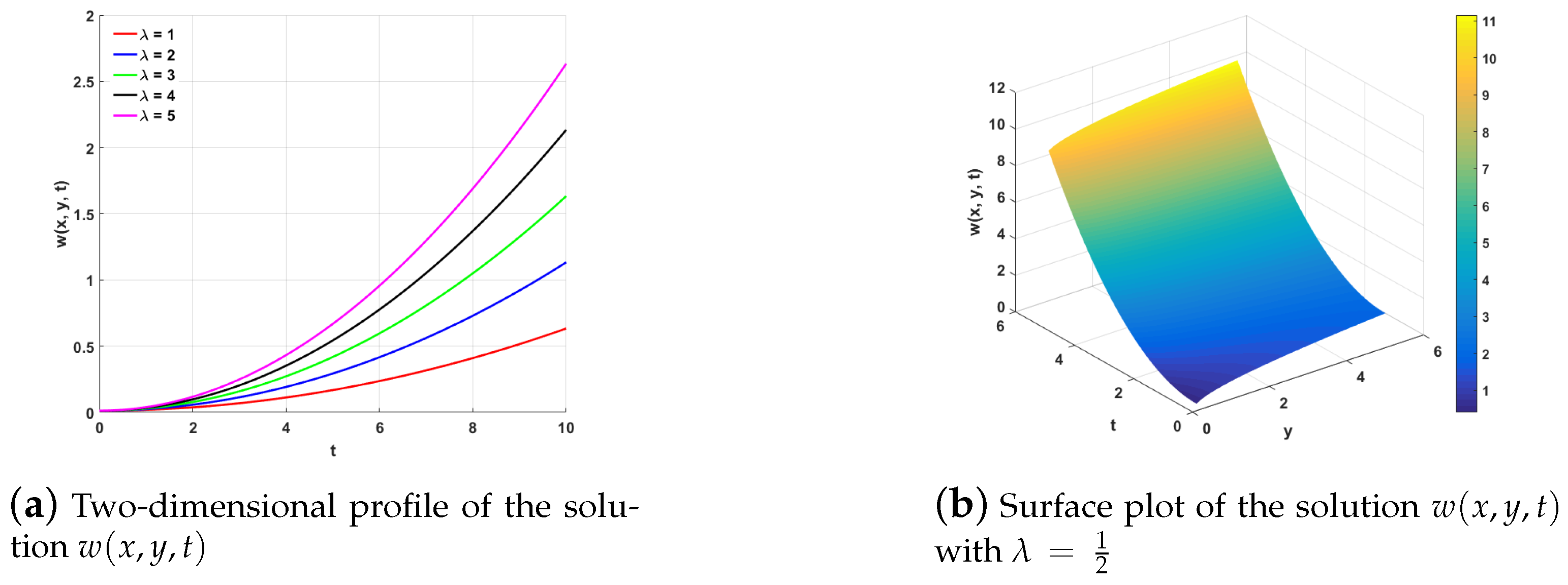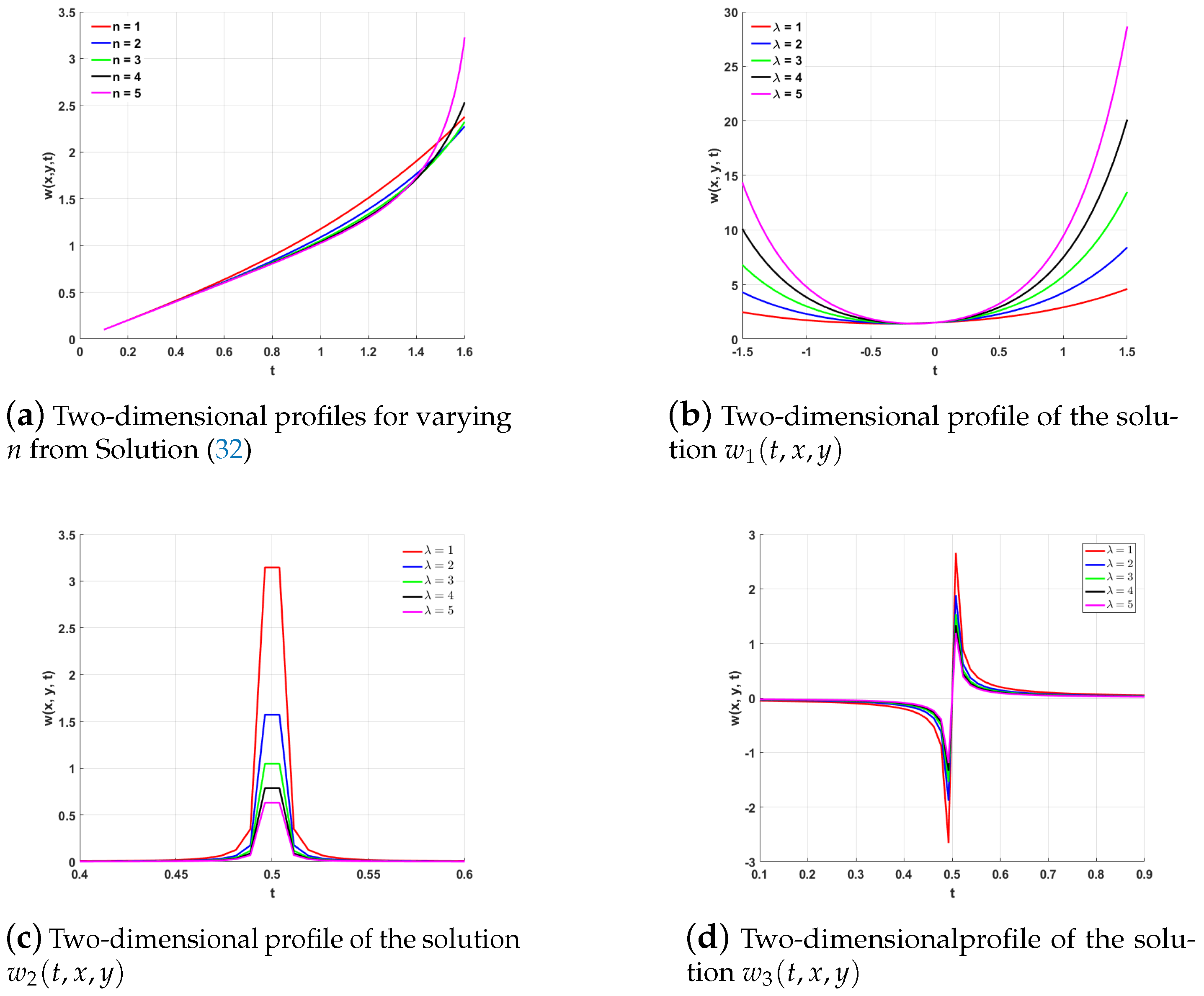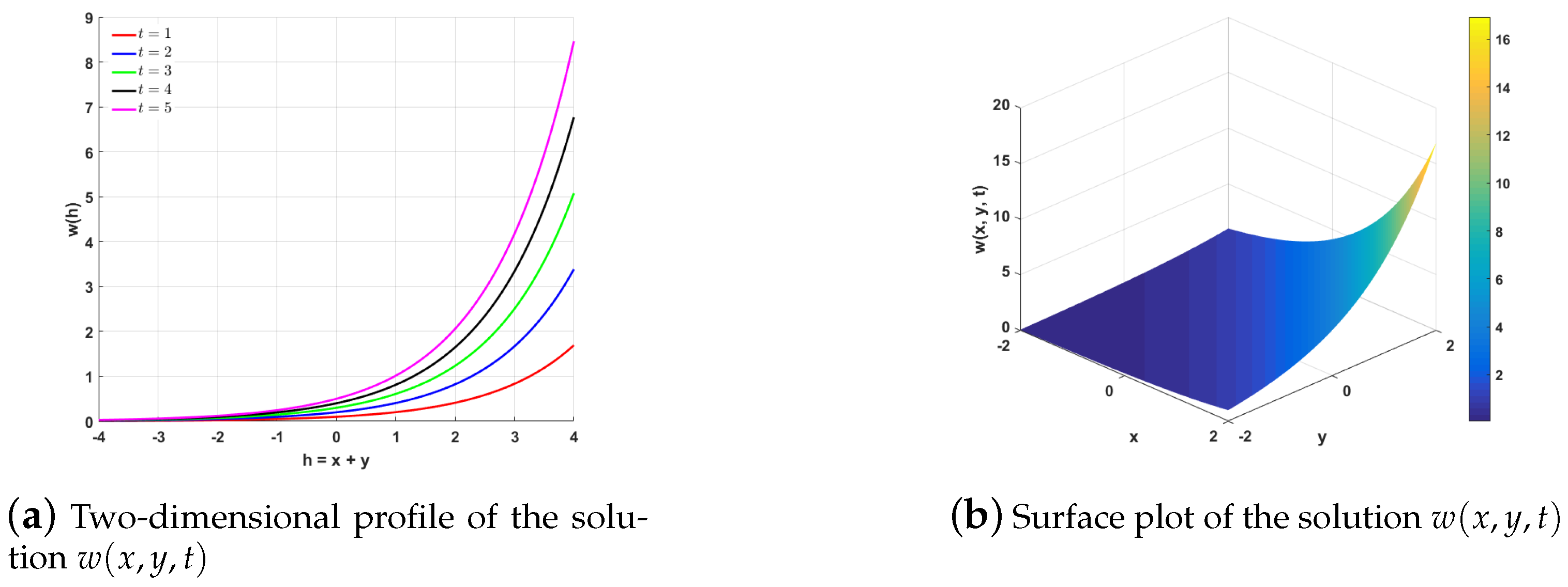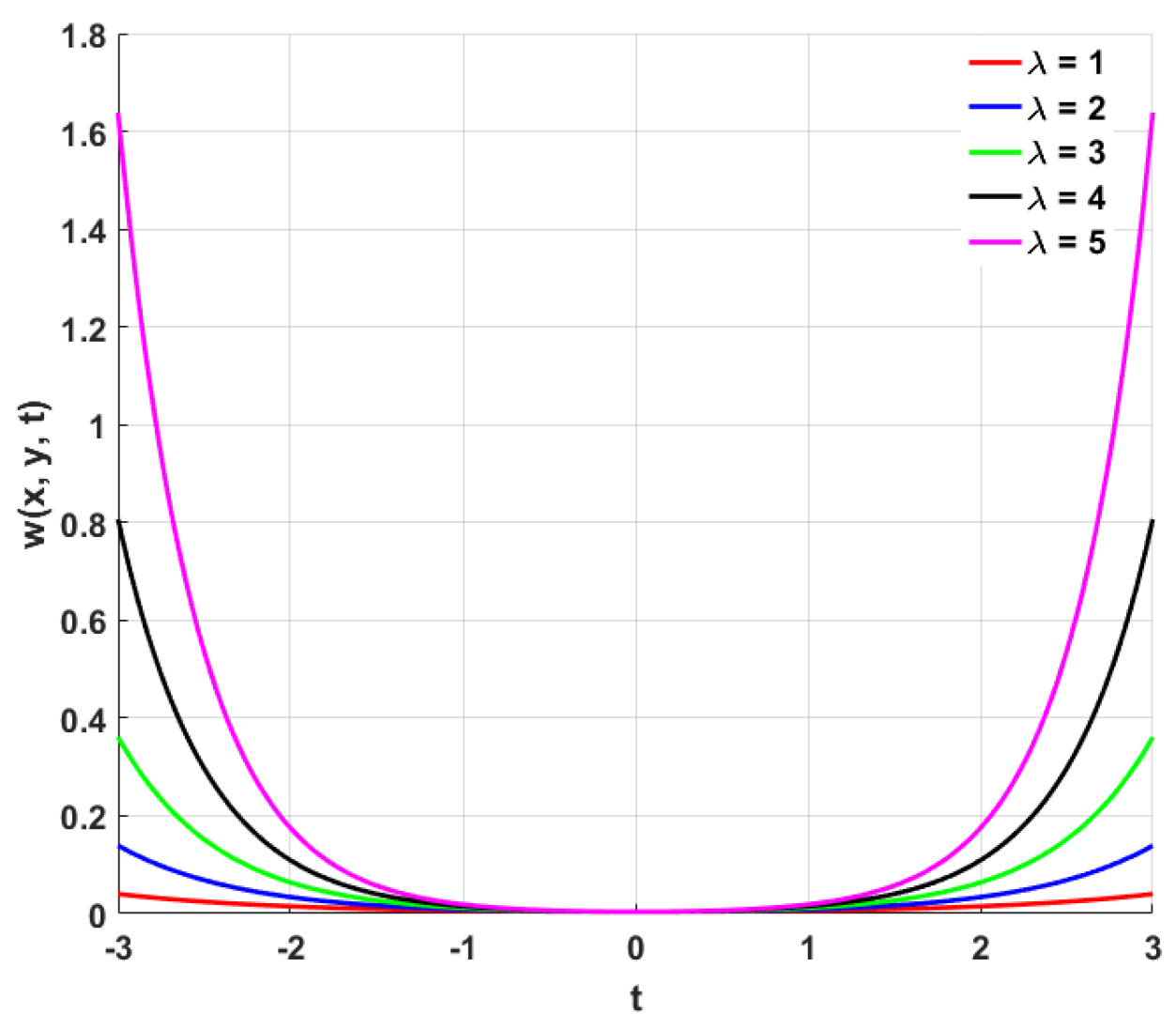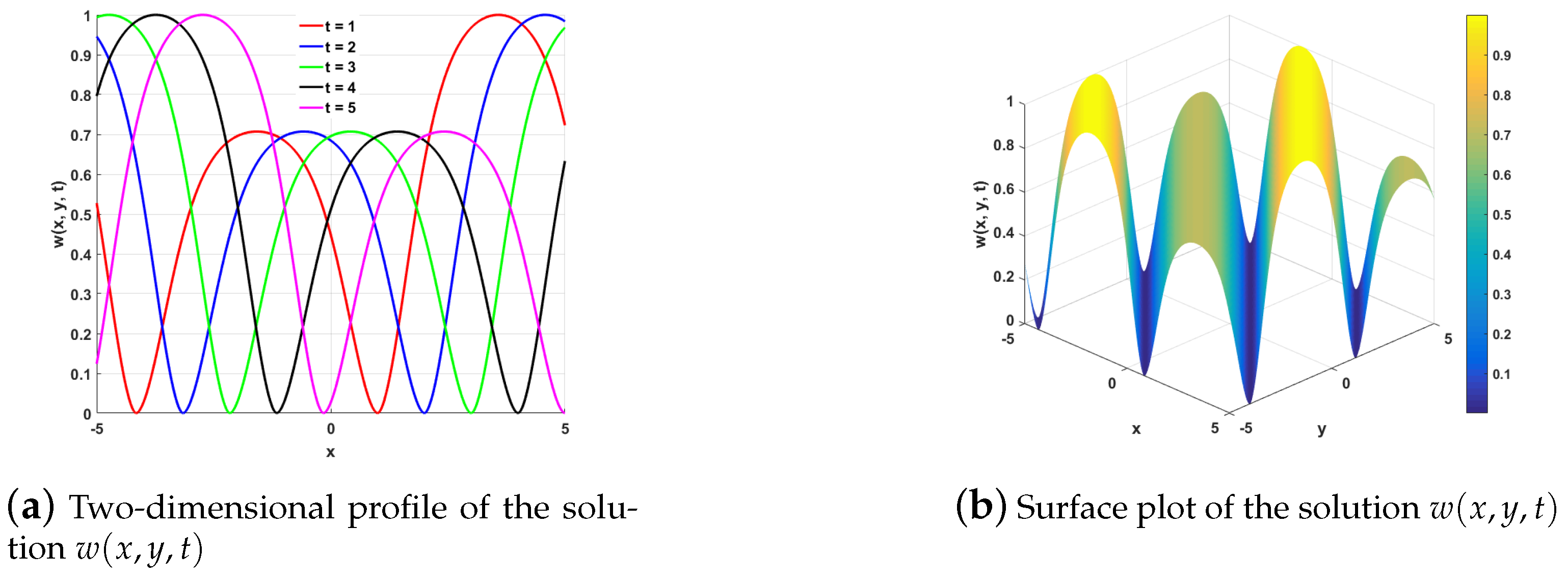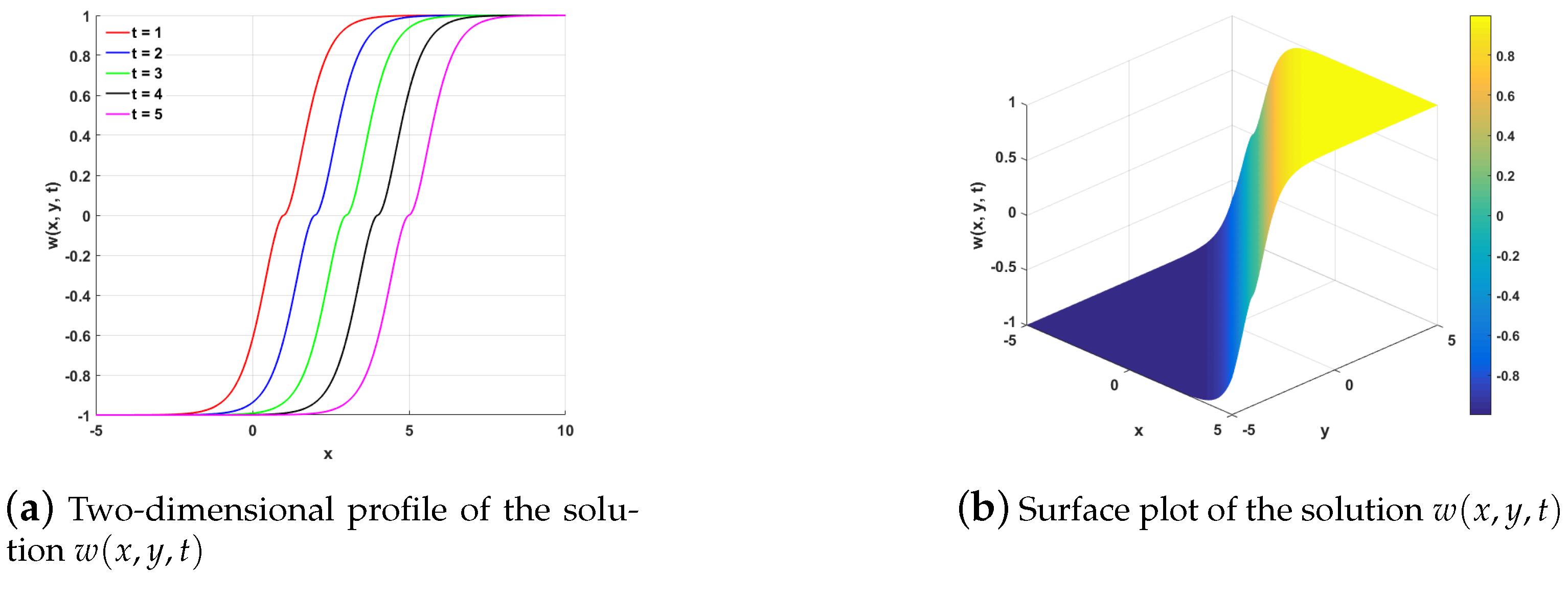1. Introduction
Partial differential equations (PDEs) exhibiting power-law nonlinearity and anisotropic spatial behavior are fundamental in describing a wide array of physical processes, such as modeling phenomena in gas dynamics, wave propagation in shallow water, and nonlinear acoustics. Among such equations, the nonlinear wave-type equation
with spatial nonlinearities was extensively analyzed by Arrigo, who obtained its Lie symmetries, constructed reduced forms through symmetry reductions, and derived exact analytical solutions for some particular cases of the source term [
1]. Motivated by the aim to explore richer multidimensional and nonlinear behaviors, we generalize this equation by introducing a power-law source term and an additional spatial direction, leading us to consider the following extended form of the equation:
This generalization enables the modeling of systems with nonlinear source behaviors and spatially symmetric diffusion along multiple directions.
Equation (
2) serves as a prototypical model for wave propagation and diffusion in nonlinear media where both the transport and reaction mechanisms exhibit state-dependent behavior. Its structure captures situations in which the spreading of a quantity is not purely linear but is instead modulated by the local gradient, while a nonlinear source term drives growth or decay within the system. Such formulations naturally arise in the study of nonlinear acoustics, elastic wave motion, and heat or mass transfer in heterogeneous and reactive environments. The generalized form of Equation (
2) enables the modeling of systems with nonlinear source behaviors and spatially symmetric diffusion along multiple spatial directions. The dispersive terms
and
, with
, represent a class of nonlinear spatial dispersions in which the wave or diffusion speeds depend on the magnitudes of the local gradients. These effects are encountered in diverse contexts, such as non-Newtonian fluid flows, wave motion in nonlinear elastic solids, and porous media transport where the effective diffusivity changes with the state of the system [
2,
3,
4]. On the other hand, the source term
encapsulates nonlinear reaction dynamics, encountered in fields such as chemical kinetics, pattern formation, and heat transfer in reactive media and population biology [
5,
6,
7]. The combination of reactive forcing and directionally nonlinear transport gives rise to rich mathematical behaviors, including finite-time blow-up, the emergence of dispersive wave trains, the formation of shock waves, and self-similarity structures. These features make Equation (
2) a rich and physically grounded model for studying nonlinear PDE phenomena.
Finding exact solutions to such nonlinear PDEs is essential for understanding the qualitative behavior and long-term dynamics of complex systems. These solutions often serve as canonical models, providing tools for validating numerical algorithms, guiding the interpretation of physical phenomena, and uncovering underlying mathematical structures. However, due to their highly nonlinear structures, these types of equations rarely yield general solution methods. To handle such equations, one powerful method is the Lie symmetry method, which offers a constructive approach to reduce the dimensionality of these equations and generate exact group-invariant solutions. In the context of nonlinear wave equations, this methodology yields important solution types: such as solitons, traveling waves, and shock-like profiles which are crucial in disciplines like plasma physics, optics, and biological transport.
Lie symmetry analysis offers a powerful method for analyzing nonlinear differential equations, as it identifies continuous transformation groups that leave the equation form invariant. These symmetries enable systematic reduction of PDEs to ordinary differential equations (ODEs), which are often easier to solve analytically or numerically. In this context, Noether’s theorem serves as a fundamental bridge between conservation laws and the symmetries of variational systems: every continuous symmetry of the action functional corresponds to a conservation law. The connection between Lie group theory and variational principles thus facilitates not only the classification of invariant solutions but also the construction of conserved physical or geometric structures intrinsic to the system [
8,
9,
10].
This method has been continuously applied in recent years to a broad range of nonlinear systems. For instance, Ghanbari et al. [
11] carried out a complete Lie symmetry analysis of a nonlinear wave equation with non-homogeneous coefficients and obtained similarity reductions leading to exact invariant solutions. Khan et al. [
12] analyzed the generalized Korteweg–de Vries equations using Lie symmetries and derived the corresponding conserved quantities using Noether’s theorem. Their method, combining symmetry analysis with conservation laws, aligns closely with our approach to equations involving power-law sources and anisotropic diffusion. Vali et al. [
13] studied the Lie symmetries of a two-dimensional Burgers-type equation, revealing how commuting vector fields lead to simplified reductions. Their approach parallels with our use of commutator algebra for symmetry reductions. Yurushev [
14] employed symmetry methods for nonlinear optical wave equations, demonstrating the role of wave-type PDEs in modeling spatial-temporal field evolution in dispersive media. Ahmad et al. [
15] combined Jacobi elliptic function expansions with Lie reductions to obtain soliton and periodic solutions to nonlinear evolution equations, highlighting the strength of hybrid analytical techniques. Debnath et al. [
16] carried out symmetry analysis and invariant quantities for nonlinear field equations emerging in mathematical physics, revealing the broad applicability of Lie symmetry methods to nonlinear PDEs. Next, Samina et al. performed a detailed symmetry analysis and derived conservation laws of the Monge–Ampère equation, and they also obtained its traveling wave and soliton-type solutions, complementing our study of nonlinear wave phenomena [
17]. Finally, Singhal et al. conducted a Lie symmetry analysis of a (3+1)-dimensional nonlinear dispersive soliton equation, obtaining exact invariant solutions and conservation laws [
18]. Gou et al. studied solitary waves in anisotropic nonlinear Schrödinger models, emphasizing the impact of directional anisotropy on localized wave behavior. These studies highlight the importance of symmetry methods and anisotropic effects in analyzing complex nonlinear wave phenomena [
19].
Our central objective (See
Table 1) is to perform a complete symmetry analysis of the generalized Equation (
2) for all possible values of the parameters
m and
n. We exploit the algebraic structure of the admitted Lie symmetries to classify and reduce the equation into various simplified forms. In addition to deriving group-invariant solutions, we use the sine–cosine and Jacobi elliptic function methods to obtain exact traveling wave and soliton-type solutions. Furthermore, we apply the Noether symmetry approach to derive conservation laws, determining specific conditions under which the equation admits variational formulations and the corresponding conserved quantities.
The structure of the paper is as follows:
Section 2 outlines the Lie symmetry analysis for various values of
m and
n.
Section 3 presents the symmetry reductions and exact invariant solutions and also obtains soliton- and wave-type solutions, supported by graphical visualizations. Moreover,
Section 4 derives conservation laws using the Noether theorem. Lastly,
Section 6 presents a discussion of the results.
2. Lie Group Analysis
To derive the Lie point symmetries of Equation (
2), we consider a one-parameter Lie group of infinitesimal transformations acting on the space of dependent and independent variables
; the corresponding infinitesimal generator is represented as
To derive the Lie symmetries, we require that the prolonged vector field
annihilates Equation (
2) on its solution manifold, i.e.,
The second prolongation
of the vector field
is represented as follows:
where the extended infinitesimal are explicitly defined in the following form:
and
represents the total derivative with respect to
.
Substituting the prolongation expressions into the invariance condition stated in (
4) and simplifying yields an overdetermined system of PDEs in the unknowns
, these equations are known as the determining equations and are given as
It follows from Equations (
13) and (
14), that
Consequently, the equation splits into the following two cases.
2.1. Case 1: Provided
Differentiation of Equation (
13) with respect to
t and substitution of the resulting expression into Equation (
12), yields
From this equation, two additional subcases can be identified as follows:
2.1.1. Subcase 1.1: Provided
This case results in the following infinitesimals:
These infinitesimals constitute a four-dimensional Lie symmetry algebra associated with Equation (
2), represented as follows:
2.1.2. Subcase 1.2: provided
In this case, Equation (
13), takes the following form:
Moreover, from Equations (
10), (
11), and (
16), we obtain
By substituting Equation (
19) into Equation (
18), and subsequently applying Equation (
12), we get the following relation:
Next, inserting this result along with Equation (
19) into Equation (
15), and equating the coefficients of like powers of
w, we derive the following system of equations:
Solving Equations (
22) and (
23), we obtain
Subsequently, Equations (
23) and (
20), result in
now, equating the coefficients of like powers of
t, we obtain the following constraints:
Based on Equation (
25), we consider the following two distinct subcases.
2.1.3. Subcase 1.2.1: provided
Thus, in this case, the expressions given in Equations (
19) and (
24) take the following form:
As a result, these infinitesimals form a four-dimensional Lie algebra of symmetries admitted by Equation (
2), represented by the following basis:
2.1.4. Subcase 1.2.2: provided
In this case, a constraint is imposed on
requiring
, and leads to the following five-dimensional Lie algebra admitted by Equation (
2):
2.2. Case 2: provided
In this case, Equations (
13) and (
14) reduce to
Differentiating it with respect to
t and inserting the resulting equation into Equation (
12), and then integration of the resulting equation with respect to
t, yields the following result:
and additionally, from Equations (
10) and (
11), we get the following forms of
and
:
Ultimately, Equation (
19) now takes the form
Next, substituting the above results into Equation (
15) and matching the coefficients of the corresponding powers of
w, we obtain
along with the following two additional cases.
2.2.1. Subcase 2.1: provided
This case results in the following five-dimensional Lie algebra:
2.2.2. Subcase 2.2: provided
Accordingly, the resulting Lie symmetry algebra in this case is six-dimensional and expressed in the form
The resulting infinitesimal generators form a Lie algebra under the Lie bracket or the commutator bracket. These symmetries are fundamental in constructing exact solutions through symmetry reductions and in deriving associated conservation laws. For each of the cases discussed above, the commutator tables, which are essential for performing symmetry reductions, are presented below.
The commutator table (
Table 2) is valid for both Subcase 1.1 and Subcase 1.2.1, where
p takes the value
for Subcase 1.1 and
for Subcase 1.2.1. While the commutator table for Subcase 1.2.2 is given in
Table 3, Subcase 2.1 is mentioned in
Table 4 and Subcase 2.2 is mentioned in
Table 5.
4. Noether’s Theorem and Conservation Laws
This section focuses on the derivation of conservation laws for Equation (
2) using the variational symmetry approach provided by the Noether theorem [
22]. It establishes a profound connection between conservation laws and symmetries in systems governed by variational principles. Conservation laws are fundamental in understanding the qualitative behavior of solutions to nonlinear PDEs. They often correspond to physically meaningful quantities such as energy, momentum, or mass, which remain conserved throughout the evolution dictated by the system. These conserved quantities serve multiple purposes; for example, they provide tools for verifying the correctness of analytical solutions, guide the development of stable and accurate numerical methods, and offer insights in assessing long-term dynamics or stability properties of nonlinear wave phenomena. In models exhibiting anisotropic diffusion and nonlinear source terms, identifying such invariants is particularly important because they shed light on the mechanisms governing wave propagation, energy distribution, and interaction within complex mediums. The implementation of Noether’s theorem typically proceeds through two essential steps:
- 1.
Derivation of the appropriate Lagrangian for the system;
- 2.
Application of Noether’s symmetry condition to derive conservation laws.
For the nonlinear Equation (
2), the corresponding Lagrangian that satisfies the underlying Euler–Lagrange condition,
is given by
The operator defined in Equation (
3) is referred to as the Noether operator associated with Equation (
2) in the context of the Lagrangian (
64), provided it satisfies the Noether identity,
where
,
, and
are gauge terms that may depend on the variables
. Condition (
65) yields a following system of determining equations, which can be solved to derive the variational symmetries and the corresponding conserved quantities:
We employ the following formula to extract the conservation laws associated with Equation (
2):
where
. Accordingly, the conserved quantities can be derived using the following expanded forms of Equation (
77):
Equation (
73) implies that
Subsequently, Equations (
73)–(
75) yield the following result:
Next, we consider the following two cases:
4.1. Case 1: provided
Using Equations (
74) and (
75) and (
81), we obtain the following.
and consequently, this branches into two additional subcases.
4.1.1. Subcase 1.1:
In this case, we obtain the following infinitesimals:
subject to
This leads to two further subcases.
4.1.2. Subcase 1.1.1:
This case results in the following conditions:
leading to the following conserved quantities:
Here, the parameters
represent arbitrary constants for
. Consequently, one can identify four distinct conserved quantities corresponding to the specific selections
This yields
This corresponds to the conservation of momentum along the x-axis. The principle of translational symmetry in the x-direction ensures that the total momentum in that direction does not change over time.
Similarly, for
, we have
This represents the conservation of momentum along the y-axis. The principle of translational symmetry in the y-direction confirms that the total momentum in that direction remains conserved.
Lastly,
results in
This conservation law arises due to the invariance of the system under time translations, indicating that, in the absence of external influences or dissipation, the total energy remains conserved over time. Such energy conservation is fundamental in physics and provides an important tool for studying the stability and long-term behavior of solutions to nonlinear PDEs.
4.1.3. Subcase 1.1.2:
This case yields the following infinitesimals:
which, in turn, result in the following conserved quantities:
When with , the corresponding conservation law stems from invariance under translations in the x-direction and represents the conservation of linear momentum along the x–axis. Setting with gives the analogous conservation law for momentum in the y-direction, arising from y-translation invariance. Finally, taking with corresponds to invariance under time translations, yielding the conservation of energy. In this case, the conserved quantity describes the total energy, including kinetic and potential components as well as the contribution from the nonlinear source term, while the associated flux terms represent the spatial transport of this energy.
4.1.4. Subcase 1.2:
We obtain the same conservation laws as those identified in Subcase 1.1.2 for Case 1.2.
4.2. Case 2: Provided
This case leads to the derivation of the following infinitesimals:
which, in turn, yield the associated conserved quantities:
provided
This set of conservation laws emerge from a symmetry structure that includes scaling, translations, and dilations in both space and time, as well as transformations involving the dependent variable
w. The parameter
controls a combined scaling in
x and
t together with a proportional change in
w, while
governs a similar scaling in
y and
t. The constants
and
correspond to translations in the
x and
y directions, respectively, and
represents time translations. By activating these parameters individually, one recovers conservation laws for linear momenta, energy, or scaling invariants. When scaling parameters are nonzero, the conserved quantities mix contributions from the field itself, its spatial derivatives, and its time derivative, reflecting the interplay between field amplitude changes and geometric transformations of the coordinates. However, for
we obtain
which consequently yields the following conserved quantities:
Herein,
(
) are arbitrary constants. Associated with Equation (
2), these conservation laws, particularly those involving spatial derivatives such as
and
, are fundamental to understanding the important properties of the underlying system. These conserved quantities signify the invariance of physical quantities such as momentum flow, directional wave propagation, and energy distribution. Their existence ensures the mathematical consistency of the model and aids in symmetry-based reductions and analytical solution methods. Moreover, these conservation laws provide a foundation for developing stable and physically consistent numerical schemes to simulate the nonlinear wave dynamics governed by the PDE.
5. Discussion
The generalized form of Equation (
2) is particularly significant because it allows for a systematic exploration of how multidirectional nonlinearities interact with nonlinear sources. Previous studies, such as Arrigo [
1], were limited to a single spatial direction and arbitrary source terms or specific functional forms, which restricted the ability to uncover soliton and traveling wave behaviors in higher-dimensional settings. Our analysis fills this gap by providing a full Lie symmetry classification for arbitrary
m and
n, thereby revealing all possible invariant reductions and associated exact solutions.
The present work provides a complete Lie symmetry analysis and classification of the nonlinear PDE (
2), which generalizes previously studied wave-type equations by including power-law source terms and anisotropic spatial nonlinearities. The choice of this equation is motivated by both physical and mathematical considerations. Nonlinear wave-type equations with gradient-dependent diffusion, such as
and
, naturally appear in diverse phenomena, including non-Newtonian fluid flows, nonlinear elastic media, and transport in porous materials [
2,
3,
4]. Moreover, power-law source terms
represent essential nonlinear reactions or forcing mechanisms present in chemical kinetics, pattern formation, population dynamics, and reactive heat transfer [
5,
6,
7]. By combining these nonlinear dispersive and reactive effects in two spatial dimensions, Equation (
2) captures a level of complexity and richness that simpler one-dimensional or linear models cannot.
The derivation of exact solutions using sine–cosine and Jacobi elliptic function methods is a significant contribution. These solutions capture traveling wave and soliton behaviors that are intrinsic to nonlinear wave dynamics but were previously unaddressed in similar two-dimensional systems. The richness of these solution families highlights the intricate interplay between nonlinear dispersive terms and the power-law source, providing insight into phenomena such as wave steepening, self-focusing, and periodic pattern formation in anisotropic media.
Another notable advancement is the systematic derivation of conservation laws via Noether’s theorem. By identifying infinitesimal symmetries associated with variational structures, we established intrinsic invariants of the system, which serve dual purposes: first, as analytical checks for the correctness of exact solutions, and second, as guides for developing energy-preserving numerical schemes. Unlike prior studies that focused mainly on symmetry reductions or specific solution forms, our approach integrates symmetry classification, exact solutions, and conservation laws into a single setup.
In terms of novelty, this work goes beyond previous literature in several ways.
- 1.
The generalized PDE (
2), featuring both anisotropic nonlinear diffusion in multiple spatial directions and a power-law source term, enables modeling of more complex physical processes.
- 2.
The complete Lie symmetry classification for arbitrary m and n values provides a systematic and exhaustive approach for further analytical and numerical investigations.
- 3.
The combination of Jacobi elliptic and sine–cosine methods with symmetry reductions yields a rich spectrum of traveling and soliton-type solutions, revealing behaviors that were inaccessible in earlier studies.
- 4.
The explicit derivation of conservation laws via Noether’s theorem complements the construction of the solution, offering a set of tools to validate analytical and computational results.
The analytical traveling wave solutions obtained in this study are not purely theoretical; they correspond closely to waveforms observed in various physical systems. For example, in nonlinear acoustics, typical parameter values are
,
, and
in the range
–
, representing quadratic nonlinearities with moderate dispersion [
23,
24]. In shallow water wave theory, cubic-type nonlinearities (
) with
and
proportional to the square of the undisturbed water depth have been reported in the framework of Boussinesq- and KdV-type models [
25].
These outcomes have multiple potential applications. In physical sciences, the derived traveling waves and soliton solutions can model nonlinear wave propagation in elastic media, shallow water, and non-Newtonian fluids. In applied mathematics and computational physics, conservation laws provide benchmarks for developing energy-conservation numerical algorithms. Furthermore, the methodology developed here is adaptable to more complex systems, including multi-dimensional PDEs with variable coefficients, generalized damping, and coupled nonlinear interactions.
6. Conclusions
In this work, we carried out a detailed Lie symmetry analysis and classification of a nonlinear partial differential equation involving power-law spatial derivatives. Based on our understanding of the existing literature, this work provides what we believe to be the first comprehensive Lie symmetry classification of Equation (
2) for general values of
m and
n, together with the associated explicit invariant solutions and derived conservation laws. Exact analytical solutions are constructed, including, for instance,
for
,
,
, and
for
,
. The results extend and unify earlier partial classifications by covering the full parameter space without imposing restrictive assumptions. This comprehensive treatment not only enriches the theoretical understanding of the symmetry structure of the equation but also lays a solid foundation for further analytical and numerical investigations. This study enables an understanding of the symmetry properties and solution structure of Equation (
2) with anisotropic and power-law nonlinearities. The obtained symmetries enabled reductions to ODEs and the derivation of exact solutions, including traveling and soliton waves via Jacobi elliptic and sine-cosine methods. The construction of traveling and soliton wave solutions through Jacobi’s elliptic and sine-cosine methods revealed the rich nonlinear behavior of the system. The solutions presented here can be applied to model nonlinear wave phenomena in practical systems. For example, in nonlinear acoustics, they can represent the propagation of high-intensity sound waves in anisotropic materials, while in fluid dynamics, they describe dispersive wave motion in layered or direction-dependent media. By adjusting the model parameters, the framework can capture both periodic and localized wave patterns relevant to real-world engineering and physical applications. Furthermore, by determining infinitesimal symmetries and employing Noether’s theorem, we systematically derived associated conservation laws that reveal intrinsic invariants of the system. These conserved quantities aid in both analytical reduction and numerical validation. These findings deepen the analytical understanding of nonlinear wave models and provide a foundation for future studies involving generalized damping, variable coefficients, and multi-dimensional systems.
The results obtained in this work are broadly relevant to physical systems where the nonlinear wave dynamics are significant. The generalized equation, together with its exact traveling wave and soliton solutions, can model phenomena such as nonlinear acoustic propagation in media with quadratic or cubic nonlinearities, dispersive–nonlinear interactions in shallow water dynamics, deformation waves in anisotropic elastic solids, and nonlinear transport in porous or heterogeneous media. These findings are also applicable to reaction–diffusion processes in chemical kinetics and biological systems. The conservation laws derived alongside the solutions provide analytical benchmarks, supporting both theoretical studies and the development of energy-preserving numerical schemes for practical engineering and scientific applications. By connecting the mathematical structure of the equation to these real-world contexts, the present work offers both theoretical insight and a foundation for further applied investigations.
